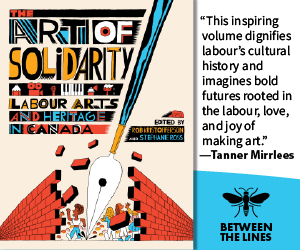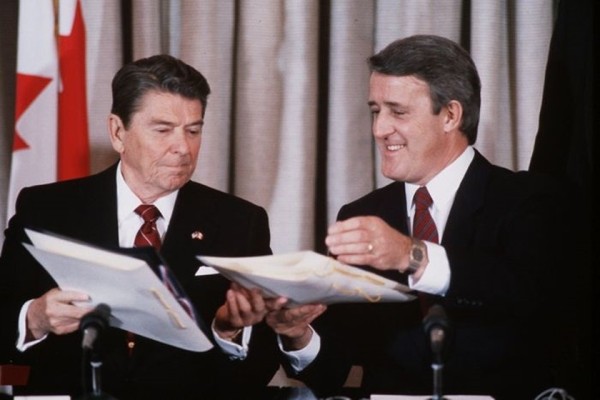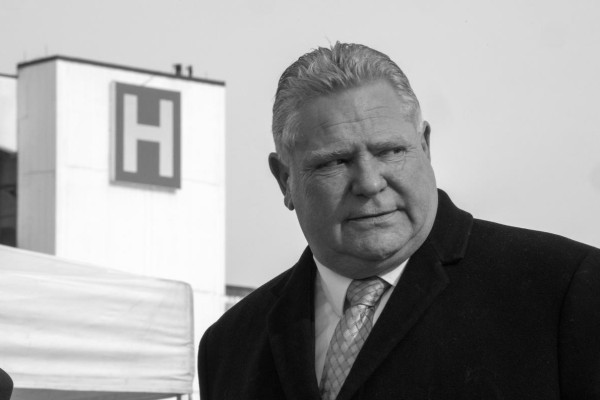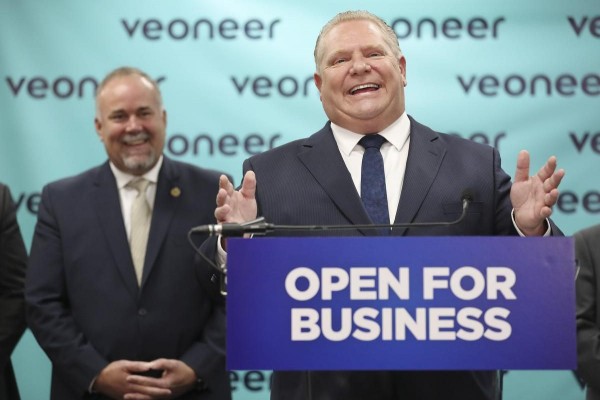We need to talk about the Conservatives
How the Tories began a long and fumbling dance with precisely the kind of politics the vast majority of Canadians don’t want

Conservatism has been shut out of government amid a hard rightward shift, political infighting and the pursuit of socially and culturally divisive wedge issues, writes Eric Strikwerda. Photo from Wikimedia Commons.
Shortly following the federal Conservatives’ defeat in the 2021 election, party leader Erin O’Toole tasked former Edmonton Centre MP James Cumming with drawing up a comprehensive report on what went wrong for the party during the autumn contest.
At the time, Cumming insisted to CBC’s The House that he intended to “hit the ground running” in his new role, and that he’d be delivering a “360 review on where we fell short, what we did right.” O’Toole insisted that the review be completed by the end of the year.
In many ways, O’Toole’s directive is not unlike that given to former Conservative cabinet minister John Baird following the Conservative’s defeat in 2019. And although its content would be for internal party consumption only, naturally Baird’s assessment of the Conservatives’ 2019 loss eventually leaked to the public. Essentially, and myopically, Baird reportedly concluded that inexperienced staffers, the campaign’s communications strategy, failures in properly vetting candidates, and overly rigid centralized control over the campaign itself together lay in back of the party’s defeat at the polls.
In like fashion, this week details of Cumming’s report have been slowly trickling into the public sphere. Early leaks suggested that O’Toole had been “over-managed” and “over-coached” during the campaign’s final weeks. He needed to get out of the broadcast studio and get out on the road more often. And the campaign’s digital and social media strategy broadly failed to connect with Canadians.
For my part, I have no shade to throw at Mr. Cumming. After all, the man suffered what can only be described as a crushing defeat to his Liberal opponent Randy Boissonnault by less than seven hundred votes.
But to my mind, Mr. Cumming’s report should have been a short read, and ought adequately if harshly summed up as something like “The experiment begun by Preston Manning in 1987 must be declared a complete and utter failure.” That’s it. That’s how the report should have read.
Let me explain.
In the mid-1980s, Mr. Manning, together with a few pals from Calgary and the oil patch, inserted his largely outrage-fueled prescription for a Confederation in which the West (as he defined it) would finally get its due—to wit: a recognition that the West’s natural resources are crucial to the national economy, but that the region has never gotten any respect from the powerbrokers in central Canada. He found a ready audience in the many westerners, especially those from Alberta, who were still smarting from the imagined damage wrought by Pierre Elliot Trudeau’s National Energy Program. And despite their hopes that newly-elected Progressive Conservative Prime Minister Brian Mulroney would at last deliver them the promised land, they fast grew disappointed to learn that Mulroney aimed to be prime minister of Canada instead of prime minister of western Canada.
But there was more to Manning’s agenda than just promoting the west’s economic contributions to the nation’s wealth, and hoping for a little respect from Ottawa. Manning also harboured deep-seated ideological positions, doubtless borne from watching his father run Alberta for a quarter of a century with a potent mix of social and fiscal conservatism.
And so, with his angry blend of western chauvinism, naively neoliberal faith in market forces to solve economic problems, American-style populism (and not western Canadian populism as has too often been claimed), and hard-right social conservatism (including conservative views of the family, sexualities, and moralities), Mr. Manning sought to re-make conservatism in Canada.
Certainly, the ensuing creation of the Reform Party of Canada, just in time for the 1988 election, appealed to many in western Canada. It also appealed to social conservative ideologues nation-wide, wistful for a past that never was.
Preston Manning speaks during a conference in October 1990. Photo courtesy Toronto Public Library/Toronto Star.
And yet, what had by 1997 become the only conservative party mere steps from forming government was the very same party that simply didn’t appeal to most voters. Canadians would not usher Mr. Manning into the Prime Minister’s Office.
It was a problem, and largely one of Mr. Manning’s own making. Having already successfully torn conservatives asunder, he tried to unite them together again, only this time under the guise of a new ‘united right.’ As soon became clear, however, Manning’s idea of a united right, now operating as the Canadian Alliance, was undergirded by the same western chauvinism, small-state and market-knows-best neoliberalism, American-style populism, and hard-right social conservatism. And it remained deeply unpopular with most Canadians, turning in only 66 seats in the 2000 federal election.
By 2004, following deep internecine fighting within Canada’s conservative movement, former Reform Party MP and president of the right-wing National Citizen’s Coalition Stephen Harper, together with Progressive Conservative Party leader Peter McKay, engineered a successful merger of the PCs and the Canadian Alliance. Two years later, with Harper leading the new Conservative Party of Canada, sans the ‘Progressive’ prefix, and widespread dissatisfaction with the long-governing and scandal-plagued Liberals, the Conservatives finally achieved what Manning never could—a minority government (albeit the smallest one in Canada’s then nearly 140-year history).
Tainting the Conservative win, however, was a deeply troubling vein of funny business and dirty tricks during the election, including most damningly the so-called ‘in-and-out’ scandal that saw Conservative operatives later forced to admit to illegally breaching federal election spending limits and submitting fraudulent election records to Elections Canada.
More problematical for conservatism, and for Canada as a whole, was the elevation of Manning protégé Stephen Harper to the Prime Minister’s Office. However hamstrung by his party’s minority government, Harper nevertheless embarked on a Machiavellian power centralizing drive marked as much by its deviousness as by its open disdain for democratic ideals.
Having trouble getting Parliament to acquiesce to government policies? Introduce a now-infamous ‘guidebook’ for Conservative parliamentary committee chairs to gum up the system, to sow confusion amongst the electorate, and to derail legitimate but inconvenient Opposition questions. Want to ram through Parliament deeply divisive and controversial legislation, but facing spirited debate from the House? No problem! Just curtail debate by burying legislation in complicated omnibus bills, and force that sludge through the pipeline. Concerned that bureaucrats and government scientists might undermine Conservative policy narratives? Issue a gag order to muzzle them. And if they don’t comply? Cut their budgets. Or just fire them. Worried that Canadians in targeted ridings might vote for a party other than the Conservatives? Flood them with ‘robocalls,’ sometimes in the middle of the night, advising them that their polling station had moved when in fact it hadn’t (and sometimes make it seem as though the calls are coming from the opposition). Bothered that the long-form census might reveal too many facts and trends about the state of Canadian society that stray too far from the Conservative party line? Do away with the long-form census altogether. Facing a non-confidence vote in the House? Prorogue Parliament.
Harper was, as Guardian journalist Nick Davies observed in 2015, nothing less than a “master manipulator” working “dark magic.”
All of these machinations, of course, together constituted more than merely seeking power for power’s sake; they were instead a surgical means to a very particular end. Harper, like his political master Preston Manning before him, sought nothing less than to fundamentally remake conservatism in Canada. Banished to the political margins would be ‘Red Toryism,’ that uniquely Canadian iteration of paternalistic conservatism described by left-leaning political scientist Gad Horowitz in his influential 1966 essay “Conservatism, Liberalism, and Socialism in Canada: An Interpretation.” There, Horowitz argued that ‘traditional’ conservatism in Canada had long been marked by an embrace of communitarianism and corporatism, a distrust of the sort of hyper-individualism so characteristic of the republic to the south, and a commitment to fiscal restraint as a means of maintaining a class-based and hierarchical social and economic and political order.
For full-blown neoliberals like Manning and Harper, this ‘gentle’ conservatism was anathema. They lionized instead a small and non-interventionist state, increased privatization of public services, ‘tough on crime’ policies, austerity, deregulation, untrammelled free-market capitalism, heightened militarism, and the elevation of the individual and individual ‘freedoms.’ These features of the new conservatism almost always ran at the expense of cooperative efforts and the common good, caring for society’s most vulnerable, and mitigating inequities and growing wealth disparities.
Supporters of Stephen Harper in Calgary in 2008. Photo by Tom Hanson/Associated Press.
Following a rapid succession election in 2008 that saw Harper’s Conservatives gain 19 more seats but remain just shy of majority territory. And in what must have been a frustrating outcome for Harper himself, the party secured only marginal gains in the popular vote. The retention of a minority government at all was less a result of Canadians’ acceptance of Harper conservatism, and had more to do with simultaneous faltering Liberal support under the hapless Stephane Dion and the rise of popular and charismatic NDP leader Jack Layton. Clearly, Canadians weren’t particularly enamoured with any of the parties. Nor were they with the election itself—voter turnout in that election remains the lowest in Canadian history.
Harper’s Conservatives finally secured a slight majority government in 2011 amid a massive NDP surge and a thorough rejection of the cold and distant Liberal leader Michael Ignatieff. But by the autumn of 2015, the Canadians who had given Harper a chance had soured on the Conservatives, and opted decisively for Justin Trudeau and the Liberals. In the wake of the election, National Post writer John Ibbitson offered up these bon mots to characterize the nation’s assessment of the Harper years: “no prime minister in history and no political party have been loathed as intensely as Stephen Harper and the Conservative Party.”
Harper’s character, at once prickly and cold and aloof, had done him no favours. More importantly, the Conservatives’ propensity to utterly fail to gauge the temper of the times on especially social ‘wedge’ issues and culturally divisive policies doomed the party to defeat. Canadians, for example, were genuinely aghast at the Conservatives’ introduction of a ‘barbaric cultural practices’ tip line encouraging Canadians to report on one another, and the party’s vaguely racist and nationalistic ‘defence’ of white, Christian, and English-speaking ‘old stock Canadians,’ a group supposedly under constant attack in this country.
The latest, of course, is the development, especially emboldened by the decidedly Trumpian swamp-clearing, ‘freedom’ loving, don’t-tread-on-us rallying cries of increasingly far-right political views. The chants of ‘lock her up’ that accompanied the election in Alberta of Rachel Notley and the NDP in 2015 are part and parcel of the post-2015 federal landscape marked by ‘Fuck Trudeau’ signs on the sides of Canadian highways and byways, by Manitoba sausage-maker and Canadian military reservist Corey Hurran’s armed breach of the grounds of Trudeau’s home at Rideau Hall, and by a disturbing rise in violent threats against politicians across Canada. So too is the emergence of newer, more extreme right-wing parties at both the provincial and federal levels over the past few years.
How did Canadian conservatism end up here, with its well-earned reputation of bigotry and anger and bitter divisiveness?
To hear John Baird, the man tasked with reporting to Andrew Scheer’s Conservative Party on what went wrong in the 2019 election, tell the story, it was “inexperienced” campaign staffers and an “overly controlled” central campaign.
Now James Cumming’s report, called by current Conservative leader Erin O’Toole to explain what went wrong in 2021, points to a lack of candidate diversity, an “over-managed” campaign, and a failure to present the Conservative brand in a positive light, especially to Canada’s ethnic communities.
Neither of these two takes hit the mark. True, both Scheer and O’Toole have their failings as leaders. But so does Trudeau. True too, both Conservative campaigns made major, usually unforced errors on the campaign trail.
But the fact is the Conservative Party has painted itself into an impossible corner, and it all started on a fateful late spring afternoon in 1987 in Vancouver’s Hyatt Regency Hotel. It was then and there that Preston Manning stepped onto the stage of the Regency Ballroom to address the Western Assembly on Canada’s Economic and Political Future. The title of his speech? “Choosing a New Political Vehicle to Represent the West.” But it was much more than that. Delegates to the Western Assembly debated whether their brand of conservatism could remake the Progressive Conservative Party from within; whether their ‘western’ style conservatism could find a voice and yet retain the tempering influence of an established national political institution. For Manning, the answer was always ‘no.’ Nothing less than a new ‘vehicle’ was required to remake conservatism, mostly in his own image.
The result, of course, is now well known. Conservatism was shut out of government for the next two decades amid a hard rightward shift, political infighting and the pursuit of socially and culturally divisive wedge issues. It’s a troubling history that continues to reverberate today (see the difficult time, at once both fraught and dangerous, the Conservative Party has had trying to respond to the so-called Truckers’ Convoy now congregating in Ottawa and other centres nation-wide).
The day in 1987 when Manning took the stage at Vancouver’s Hyatt Regency was the same day that conservatism in Canada moved sharply away from its ‘progressive’ roots, and began its long and awkward and fumbling dance with precisely the kind of politics that the vast majority of Canadians don’t want.
Eric Strikwerda teaches Canadian history at Athabasca University. He is the author of The Wages of Relief: Cities and the Unemployed in Prairie Canada, 1929-1939 (AU Press, 2013). At present he is working on a history of western Canada following Canada’s acquisition of the region in 1870.










_600_400_90_s_c1.jpg)